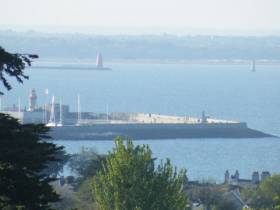Displaying items by tag: Kingstown 200
Gentle Start to Friendly Dun Laoghaire Regatta 2017
The difference between an un-sailable calm and a light breeze which is just good enough to provide decent racing is enormous when you’re trying to get a very large regatta off to a successful start. So although the fleet racing on Thursday in the first jousts of the VDLR 2017 in Dublin Bay did not include some classes which became fully involved yesterday, all the heavy hitters were out and racing full-on in a sou’easter which was of exactly the right strength for the first race of a large and complex event.
This years’s special ingredient, the Classics and Traditionals racing for the prestigious Kingstown 200 Trophy, also had their first foray afloat, and W M Nixon found himself in their midst wondering at their almost infinite variety, while getting the occasional glimpse of the racing among the modern fleets.
While the Classics may show themselves to be amenable to a certain level of organisation, trying to get a varied Traditional fleet to function in unison is about as easy as herding cats at a crossroads. So when that remarkable husband and wife team of Con Murphy and Cathy MacAleavey were tasked with setting up a Sub-Committee to look after the special needs of the Classics and Traditionals which were being invited to Dun Laoghaire to compete for the Kingstown 200 trophy within the Volvo Dun Laoghaire Regatta 2017, they found themselves on a steep learning curve, for all that both are already much involved in classic dinghy racing with both the Water Wags and Shannon One Designs.
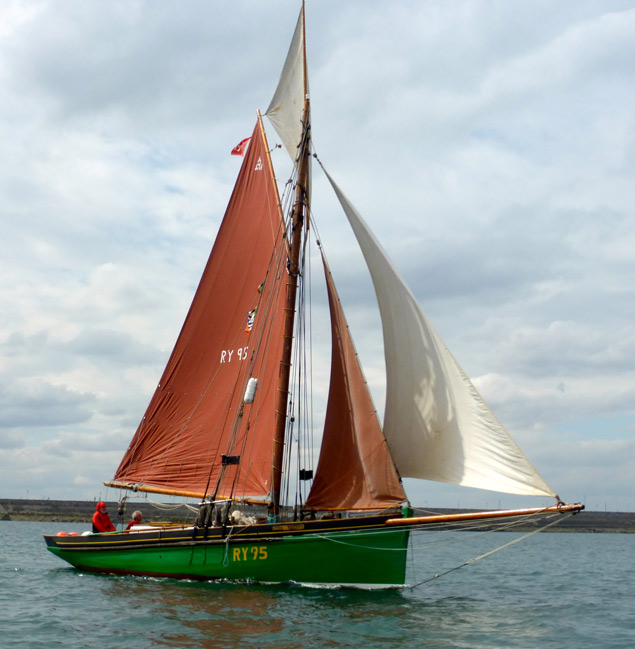 Joe Pennington’s 1895-vintage Manx longliner which he restored himself. He turned up single-handed and more or less unannounced, but has been welcomed and provided with a crew. Photo: W M Nixon
Joe Pennington’s 1895-vintage Manx longliner which he restored himself. He turned up single-handed and more or less unannounced, but has been welcomed and provided with a crew. Photo: W M Nixon
Some of the traditional boats plan their programmes years in advance, while others make them up as they go along. So as entry deadlines came and went, it was still difficult enough to give a realistic assessment of who and what would be there, and where and when.
But with Guy Kilroy of the Water Wags appointed to be the vital direct liaison officer for what is sometimes best described as the Awkward Squad, it was clear that the Murphy/MacAleavey team had taken on board lessons learned from other major commemorative regattas, where attempts to include the Golden Oldies had assumed they were as au fait with the local regular racing scene as though who were frequent participants, and they were too often left to their own devices in a strange environment.
By contrast, the environment in and around the Dun Laoghaire clubs this weekend is about as friendy and un-strange as it could be, and at the National Yacht Club – with special berthing for the Classics and Traditionals along a pontoon immediately east of and parallel to the Carlisle Pier - the Golden Oldies have a home-from-home, and the mood was reinforced by helpfulness and friendliness from the start.
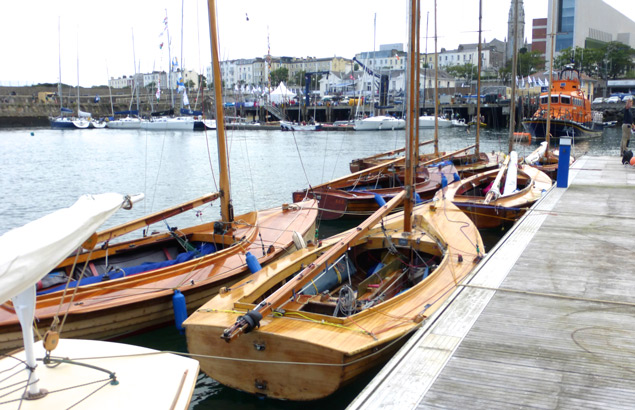 Although the Mermaids have very little class racing in Dublin Bay, the biennial Dun Laoghaire Regatta at their ancestral home is one of their major events. Photo: W M Nixon
Although the Mermaids have very little class racing in Dublin Bay, the biennial Dun Laoghaire Regatta at their ancestral home is one of their major events. Photo: W M Nixon
As to the oldies fleet, it may not be huge, but it’s fascinating in its variety, with a stroll down their dedicated pontoon like a visit to a good maritime museum. And when we add in extras like the Fife ODs over from the Menai Straits, not to mention local fleets almost taken for granted such as the Water Wags from originally 1887 but now racing boats from 1900, the Howth 17s from 1898, the Mermaids from 1932, and the IDRA 14s and the Glens from 1946, then we really are looking at a fine array of wooden boats before we add in the “Honorary Classics”, built in fibreglass but of traditional form.
While the One Designs went off to race with the main fleet, Con Murphy himself took on responsibility for getting the “Mixed Classics” cleanly away from a start line in Scotsman’s Bay on a course which he hoped would keep us clear of most of the cut-and-thrust of the modern machines. Our renowned Race Officer was in a benign mood as it was both his 60th birthday, and he was well pleased with the size and variety of the eclectic fleet which was emerging from the harbour and heading towards his starting area.
 Birthday boy. While in the midst of organising the oldies and classics in their racing for the Kingstown 200 Trophy, they ever-youthful Con Murphy (seen here with Regatta Secretary Ciara Dowling) celebrated his 60th birthday on Thursday. Happy birthday from us all!
Birthday boy. While in the midst of organising the oldies and classics in their racing for the Kingstown 200 Trophy, they ever-youthful Con Murphy (seen here with Regatta Secretary Ciara Dowling) celebrated his 60th birthday on Thursday. Happy birthday from us all!
So in the spirit of the regatta and the mood of the day, the great man asked us what sort of course we’d like, and the popular choice for that first race was a nice reach out and a nice reach back. “And we’d like you to finish in-harbour if that’s okay” added our Race Officer. As gaffers think that finishing in-harbour is the only way to finish, that was no problem either.
Although the basic tide was ebbing southeast out of Dublin Bay, right in there in the inner reaches of Scotsmans Bay we found a distinct west-going counter-eddy, and the good news is that it is indeed indicated in the Port of Dublin Tidal Stream Atlas which we featured on Afloat.ie a couple of days ago. But we also had to take account of it in making our northeast-heading start as by now a grand little southeast breeze had filled in. So pre-start manoeuvres were rather more about avoiding other boats than identifying them too close, but happily the fleet got cleanly away, and as we settled down for a good reach towards the seaward buoy, we could suss them out in more detail and assess the cut of their jibs.
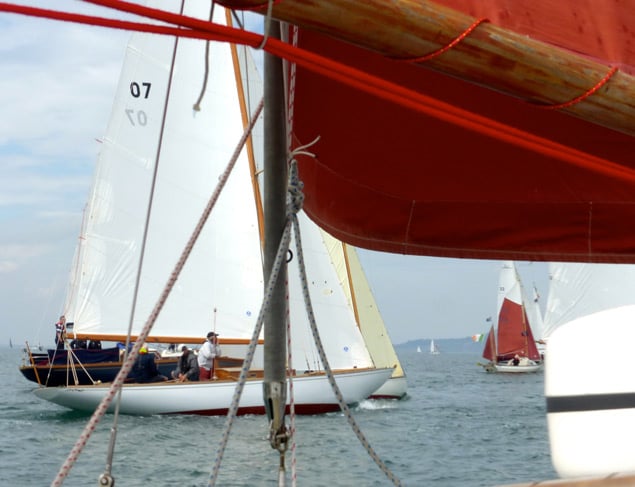 Making in for the start, DB24 Perwinkle, Nicholson 36 Samphire, a brace of Colleens, and an American Morris 44. Photo: W M Nixon
Making in for the start, DB24 Perwinkle, Nicholson 36 Samphire, a brace of Colleens, and an American Morris 44. Photo: W M Nixon
After several major Old Gaffer events in which our boat had raced against Sean Walsh’s Heard 28 Tir na nOg, I’d secured a berth on her with the former International President Old Gaffers Association, which in turn freed up Sean’s crewman John Shaw to go and sail with Joe Pennington from the Isle of Man on the 1895-vintage Manx longliner Master Frank. Typically, Joe had arrived in single-handed and virtally unannounced to take part, knowing he’d find a crew once he got there, and so we found ourselves going through the start line with Master Frank close aboard on the port quarter.
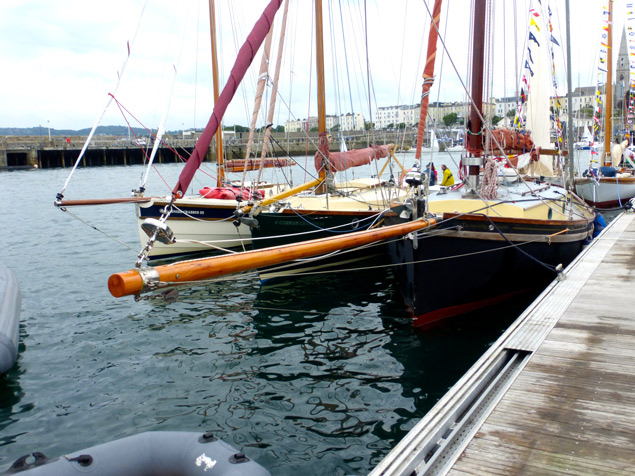 Not a bowsprit to be trifled with……Moving the mast six inches forward has greatly improved the steering characteristics of Sean Walsh’s Heard 28 Tir n nOg. Photo: W M Nixon
Not a bowsprit to be trifled with……Moving the mast six inches forward has greatly improved the steering characteristics of Sean Walsh’s Heard 28 Tir n nOg. Photo: W M Nixon
Aboard Tir na nOg, we were in test pilot mode, as Sean has had the multi-skilled Barry O’Loughlin move the mast all of six inches further forward. Tir na nOg was always a fast boat, but a bit hard on her helm. Now she’s as light as a feather to steer, and even faster with it's soon we were in the groove with topsail up and picking up places left and right, for our start had only been so-so.
Obviously the newly-returned and beautifully-restored Dublin Bay 24 Perwinkle was going to be setting the pace, and she was soon ahead, but as the race went on it was clear the handsome Welsh visitor Myfanwy (Rob Mason) was going like a train. Superficially, she looks like Hal Sisk’s Peggy Bawn of 1894 vintage, but while Myfanwy at three years younger is unrestricted by Rating Rules which were modified after Peggy Bawn was built, consequently she sets more sail, and this was very much her day.
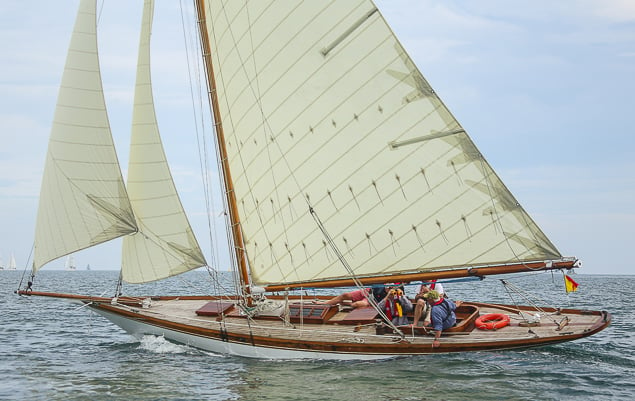 Rob Mason’s own-restored 1897-vintage 36ft Myfanwy from Milford Haven is proving one of the stars of the show. Photo David O’Brien/Afloat.ie
Rob Mason’s own-restored 1897-vintage 36ft Myfanwy from Milford Haven is proving one of the stars of the show. Photo David O’Brien/Afloat.ie
 Hal Sisk’s 1894-vintage Peggy Bawn is sailing with cotton sails preserved by James McAsey, who owned her in Dun Laoghaire from 1919 to 1988. Photo David O’Brien/Afloat.ie
Hal Sisk’s 1894-vintage Peggy Bawn is sailing with cotton sails preserved by James McAsey, who owned her in Dun Laoghaire from 1919 to 1988. Photo David O’Brien/Afloat.ie
Another boat very much having her day was Jack O’Keeffe’s much –travelled Drascombe. “Drascombes don’t race” the committee had been told, but if Jack wasn’t racing, then I don’t know what he was doing. He had his little floating home in flying mode, and finished the race well ahead of many boats you’d have expected to have had him comfortably astern.
 Drascombes aren’t designed to race, but Jack O’Keeffe of Cork has turbo-powered his boat to do just that, and he had a great race. Photo: W M Nixo
Drascombes aren’t designed to race, but Jack O’Keeffe of Cork has turbo-powered his boat to do just that, and he had a great race. Photo: W M Nixo
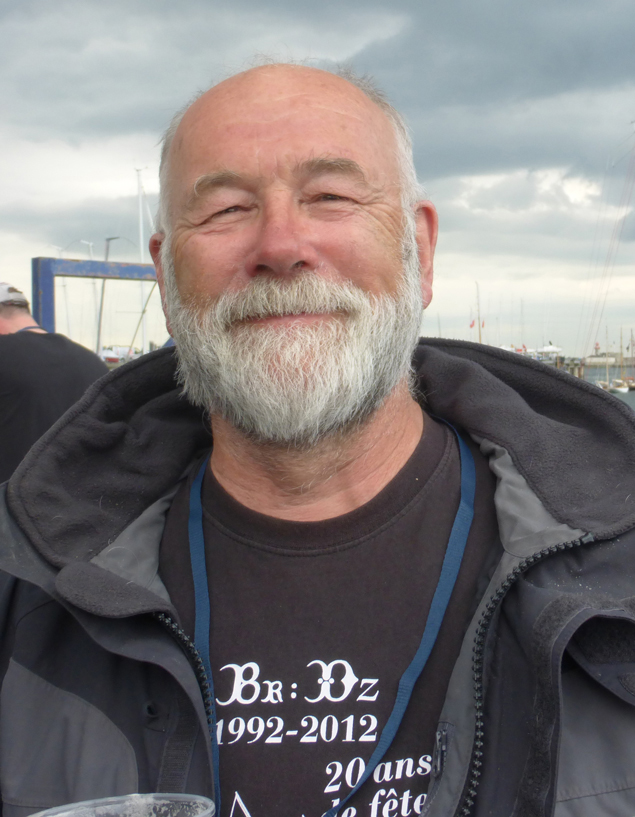 Jack O’Keeffe is the very spirit of Drascombe sailing in Ireland. Photo: W M Nixon
Jack O’Keeffe is the very spirit of Drascombe sailing in Ireland. Photo: W M Nixon
Heading back towards the harbour, we’d the remarkable sight of Dublin Bay Colleens and Peggy Bawn close ahead of us – it could have been any season in the past hundred and more years. But we also had a clutch of Ruffian 23s heading towards us with that single-minded focus which is a Dublin Bay One Design speciality, but may not be in the mental makeup of traditional and classic sailors.
 Frank Larkin of Limerick sailing the Colleeen Bawn in hot pursuit of the Peggy Bawn. Photo: W M Nixon
Frank Larkin of Limerick sailing the Colleeen Bawn in hot pursuit of the Peggy Bawn. Photo: W M Nixon
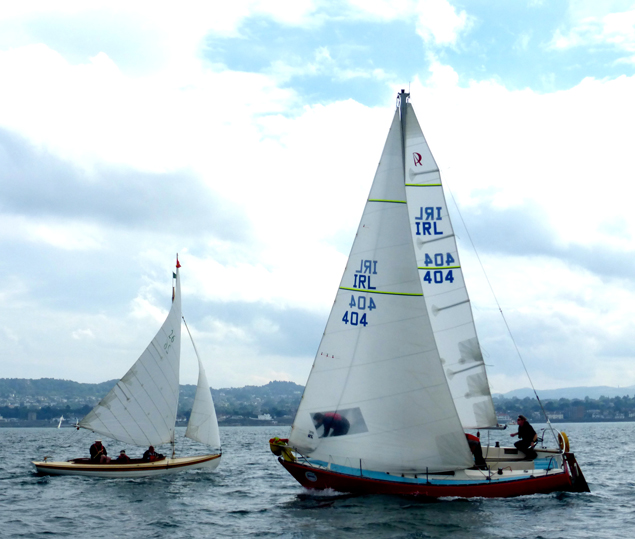 “Don’t you know we’re racing?” “Well, so are we…” Close encounter between Colleen and Ruffian 23. Photo: W M Nixon
“Don’t you know we’re racing?” “Well, so are we…” Close encounter between Colleen and Ruffian 23. Photo: W M Nixon
Fortunately the Classics Sub-Committee’s forward thinking seems to have included the provision of a RIB to shepherd the Golden Oldies around the close-encounters-of-the-first-kind situations which can suddenly arise in the crowded racing waters of the southern half of Dublin Bay, and they tactfully ensured that no-one met by accident.
The in-harbour finish seemed so right for the day that was in it, particularly as we made it in one tack from the harbour mouth to the line. And the mood afterwards was simply euphoric. Half the fleet had been strangers as we joined ship a bit rushed as usual, we got to know them better sailing against them in perfect conditions for the first acquaintance, and we returned to the harbour as friends.
So it took a long time to get from the boats to the club forecourt, not because there was any delay in the ferry shuttle service from pontoon to quayside, but because there were so many different boats – some of them very different indeed - and people to meet, including Rob Mason and his deservedly exuberant crew, who’d made a cracker of a passage to Dublin Bay, just 29 hours from the very head of Milford Haven, and were now racing with an equal elan.
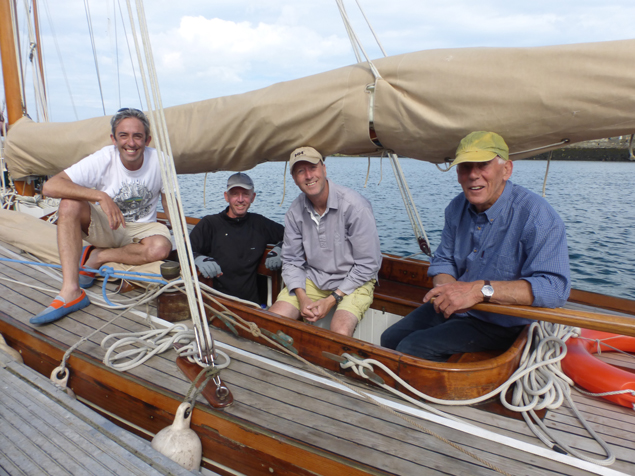 The Flying Welshmen – Myfanwy’s crew with owner, skipper and restorer Rob Mason on right. They made a fast passage from southwest Wales, and have been going even faster since. Photo: W M NixonAnother area of interest was the restored Nicholson 36 Samphire of St Osyth, with which Frank O’Byrne of RStGYC and his gallant team are rightly delighted. They bought her in the south of England with no idea that her first home port in 1963 was Dun Laoghaire with first owner Peter Morck, but now she’s back and a useful indicator for anyone who might be thinking in terms of a moderately priced modern classic such as Brian Comerford has with the Robb 37 yawl Verve of the same vintage.
The Flying Welshmen – Myfanwy’s crew with owner, skipper and restorer Rob Mason on right. They made a fast passage from southwest Wales, and have been going even faster since. Photo: W M NixonAnother area of interest was the restored Nicholson 36 Samphire of St Osyth, with which Frank O’Byrne of RStGYC and his gallant team are rightly delighted. They bought her in the south of England with no idea that her first home port in 1963 was Dun Laoghaire with first owner Peter Morck, but now she’s back and a useful indicator for anyone who might be thinking in terms of a moderately priced modern classic such as Brian Comerford has with the Robb 37 yawl Verve of the same vintage.
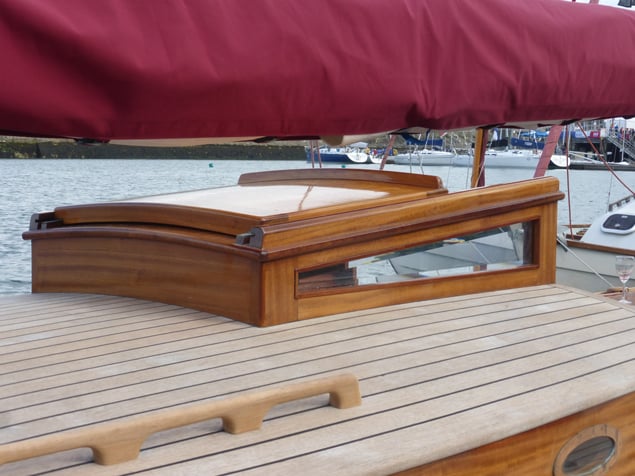 Detail of Perwinkle’s coachroof. The quality of the workmanship by Skol ar Mor in southern Brittany is simply breath-taking. Photo: W M Nixon
Detail of Perwinkle’s coachroof. The quality of the workmanship by Skol ar Mor in southern Brittany is simply breath-taking. Photo: W M Nixon
There are some good boats of a certain age out there just looking for the right TLC to give excellent value, but inevitably in this 200th Anniversary Special regatta, it’s the uber-classics which merit most attention. Periwinkle is simply breath-taking – you just go aboard and sit in awed silence amidst all that exquisite woodwork – the effect of total teak is almost trance-inducing. And last night, the Howth 17s arrived after racing across the bay, insouciant in never having changed from their jackyard topsail-toting gaff rig, so it’s oldies wall-to-wall.
But the sight of sights has to be Peggy Bawn and Myfanwy berthed side by side. 1894 and 1897. Carrickfergus-built and Birkenhead-built. We’ve a remarkable marine heritage in the Irish Sea. And right now, two of the most important examples of it are in Dun Laoghaire to honour the Harbour’s Bicentenary.
 To have two high vintage classic beauties like Peggy Bawn (left) and Myfanwy together in Dun Laoghaire Harbour for the 200th Anniversary makes it all very special indeed. Photo: W M Nixon
To have two high vintage classic beauties like Peggy Bawn (left) and Myfanwy together in Dun Laoghaire Harbour for the 200th Anniversary makes it all very special indeed. Photo: W M Nixon
Launch of DLR Spring into Heritage Programme of Events
#DLRHeritage - Easter is over but there’s plenty more to do with this year’s Spring into Heritage (28 April-18 June) programme organised by Dun Laoghaire-Rathdown County Council.
Beginning next Monday, the DLR Heritage programme offers a variety of events and free guided walking tours. Among them are those with direct maritime themes connected with Dun Laoghaire Harbour which this year celebrates its Bicentenary.
Given this special 200th anniversary, guided walking tours will prove to be particularly apt as they delve into the magnificent engineering of the historic harbour built using granite from nearby Dalkey. The harbour originally began with construction in 1817 of a single pier, the East Pier.
Nearby to the popular East Pier, there will be also be guided tours of the National Maritime Museum housed in the former Mariners Church located next to the DLR Lexicon Library.
On the other side of the harbour, just beyond the West Pier, there will also be tours of Seapoint Martello Tower built to defend a possible Napoleonic invasion. The stone-cut structure affords a wonderful panorama with views sweeping across Dublin Bay.
Why not take a visit to the Dalkey Castle & Heritage Centre. Tours explore and explain the 15th century medieval fortified towerhouse, where cargoes were once stored from ships that anchored in Dalkey Sound which then acted as the main port for Dublin.
Other none coastal venues including tours of historic houses set in parkland throughout the borough are available. Noting some events require pre-booking. For more details including downloadable leaflet click here.



























